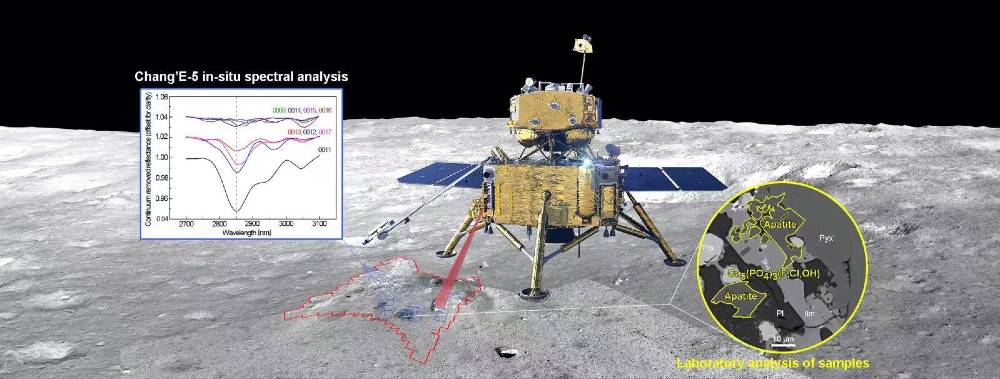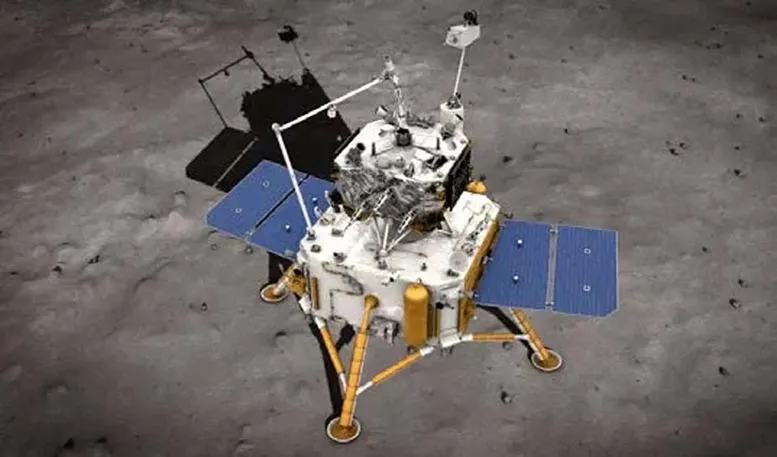Oceanus Procellarum, an old mare basalt whose name translates to “Ocean of Storms,” on the Moon, may be able to help scientists figure out where lunar water comes from.
In 2020, China’s lunar lander Chang’E-5 used on-board spectral analysis to offer the first real-time, on-site definite confirmation of a water signal in basalt rocks and soil. Laboratory testing of samples retrieved by the lander in 2021 confirmed the discovery. The Chang’E-5 team has finally discovered the source of the water.

Nature Communications Published The Researchers’ Findings On June 14th
“Laboratory examination of lunar return samples and spectral data from in-situ lunar surface surveys were employed together for the first time in the world to analyze the presence, form, and amount of ‘water’ in lunar samples,” stated co-corresponding author Li Chunlai of the Chinese Academy of Sciences (NAOC).
“The findings give a ground truth for the interpretation and calculation of water signals in remote sensing survey data and accurately address the question of the distribution features and source of water in the Chang’E-5 landing zone.”
Did the Moon Have Rivers Or Streams?
Chang’E-5 did not find any lunar rivers or springs, but it did find 30 hydroxyl parts per million on an average in rocks and soil on the Moon’s surface. The molecules, which are made up of one oxygen atom and one hydrogen atom, are the most typical consequence of water molecules chemically reacting with other substances.
Despite being the “poor end of lunar hydration properties,” according to Li, hydroxyl is to water what smoke is to fire.
The Samples Of The Lunar Surface
The samples were taken at the warmest phase of the Moon’s day, when the surface was dry, at temperatures nearing 200°F. Low solar winds, which can contribute to hydration at high enough power, coincide with the period.
Even in such dry settings, the hydration signals appeared—so where did they come from, the researchers wondered?
The hydroxyl was found to come from two different sources after being detected by the lander’s on-board lunar mineralogical spectrometer in 11 rock and soil samples and confirmed by five additional multi-part laboratory analyses on eight of the samples. A small amount was found in glassy material created by solar winds interfering with the lunar surface, similar to what was found in an Apollo 11 sample collected in 1971 and tested in the early 2000s.
However, the Chang’E-5 sample only had about a third of the amount of hydroxyl-containing glass generated by solar wind as the Apollo sample.
Role Of Solar Winds In The Lunar Water
This shows that the solar wind played a role in the hydroxyl content of the Chang’E-5 landing site, albeit in a minor way. Apatite, a crystalline, phosphate-rich mineral found on both the Moon and Earth, contains the majority of the hydroxyl in the Chang’E-5 samples.
“This excess hydroxyl is indigenous, demonstrating the presence of lunar-originated internal water in the Chang’E-5 lunar samples, and that water played an important role in the formation and crystallization of the late lunar basaltic magma,” Li explained, referring to the Chang’E-5 landing site in Oceanus Procellarum’s mare basalt.
Conclusion
We are learning more about the formation and evolution of not only the Moon, but also the solar system, by investigating lunar water and its source. In addition, lunar water is expected to support future human in-situ lunar resources.”
Chang’E-5’s successors, Chang’E-6 and Chang’E-7, will be used in future lunar explorations, according to the researchers. They will continue to study lunar water using remote sensing, on-site detection, and laboratory analysis, according to Li, in order to better understand the source, distribution, and temporal variation of lunar water, including polar ice.
